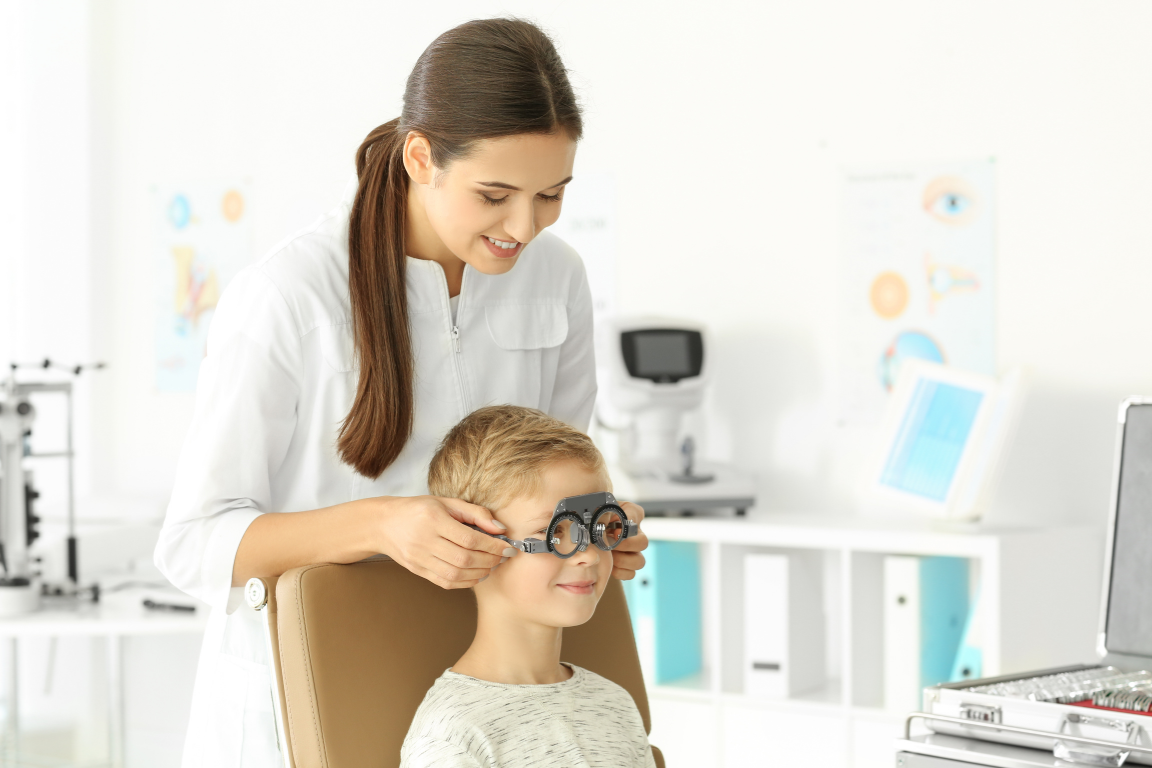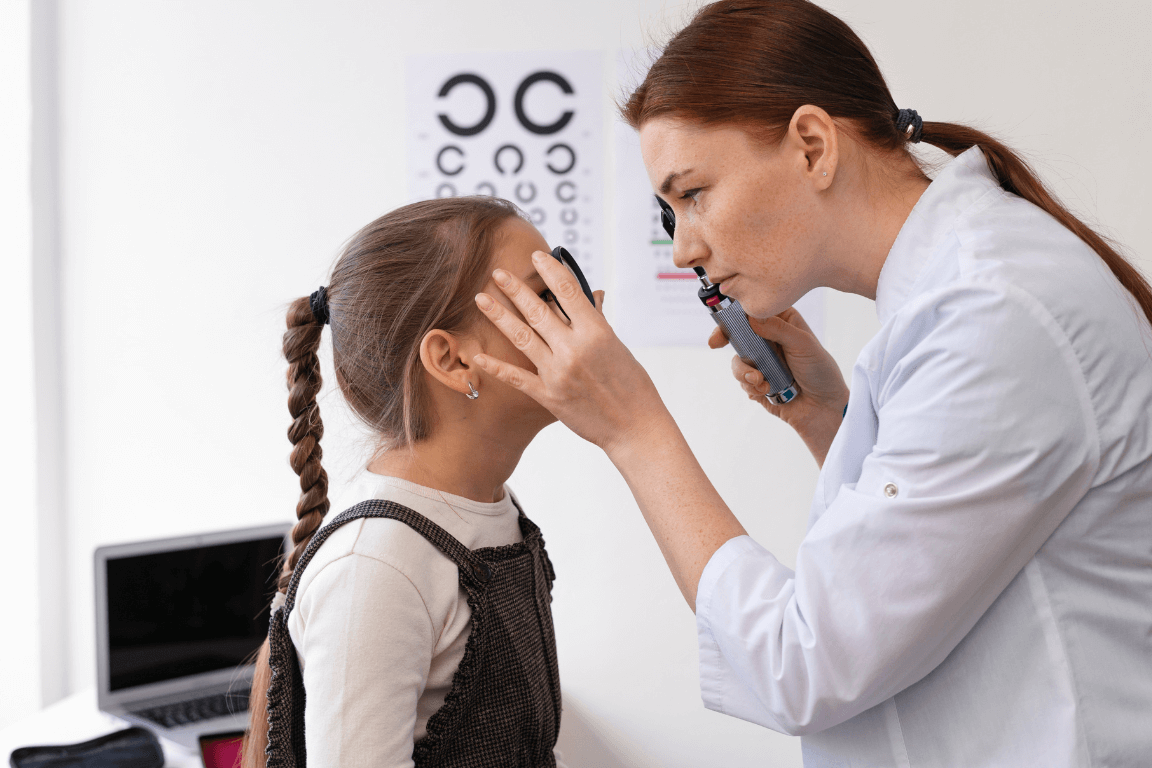When computers were first invented and then eventually became common household items, it was really only adults who used them. However, fast-forward to the 21st century, and we find children and teenagers using computer devices with increasing regularity. In fact, not only do children use computers for leisure, but many are now required to use them in the classroom and at home as part of their schooling. During the COVID-19 pandemic, when traditional classrooms closed down, children needed to connect through virtual classrooms online or risk falling behind in their schoolwork. Unsurprisingly, during the pandemic, reports of digital eyestrain among children increased up to 60%.1
Though the findings of symptomatic digital eyestrain in children can be much the same as those observed in adults, the contributing factors can differ, and effective management strategies may need adapting for our younger computer users.
What causes digital eyestrain in children?
Many factors that contribute to the onset of eyestrain in children while on a digital device are similar to those in the adult population. Essentially, the visual demands of the task exceed the abilities of the patient to perform it comfortably.2
Typical contributors to digital eyestrain include:2,3
- Poor lighting
- Glare
- Pre-existing undiagnosed binocular vision disorders or refractive errors
- Suboptimal ergonomics of the computer and table set-up
- Dry eyes
However, certain characteristics of children are likely to make them more susceptible than adults. For example, young children tend to be less self-aware and have a poorer understanding of healthy limits.2 This can lead to excessive and prolonged computer use, ignoring any symptoms of discomfort or fatigue until they reach a particularly severe degree.
Children also tend to be very adaptable, which may lead to them simply putting up with symptoms rather than taking the initiative to ameliorate or address them.2 For example, if the screen is too bright, a child may not think to adjust the brightness settings. Similarly, if dry eye symptoms are starting to become noticeable, a child may be more likely to instinctively rub their eyes but not consider taking a break or asking for lubricant eyedrops.
As most computers are set up for adult-sized humans, ergonomics for a child using a screen arranged on a desk can be particularly poor. If the chair is too low and the screen too high, the sustained up-gaze for a child can lead to binocular vision discomfort.2 In this elevated gaze position, the upper eyelid is also retracted to a greater degree, which can lead to increased tear evaporation from the ocular surface and subsequent dry eye symptoms.2
One relatively recent study conducted in 2021 found that digital eyestrain in the paediatric population was significantly associated with:4
- Male gender. However, there have also been some reports of digital eyestrain being more prevalent in girls than boys.
- The preferential use of smartphones over other digital devices. While decreased blink frequency and quality contribute to dry eye symptoms when using a smartphone, the shorter working distance can also lead to greater visual asthenopia.3
- Age older than 14 years. This age group has been found to experience more dry eye symptoms and tend to spend more time on smartphones compared to younger age groups. However, it’s known that digital device use increased across all ages during the pandemic, even in children under the age of three.3
- Using a digital device for more than 5 hours per day.
- Playing games on a smartphone for more than an hour per day.
Strategies to manage digital eyestrain in children
Parents, school teachers, and optometrists all play a role in preventing and alleviating digital eyestrain in the paediatric population. As the primary eyecare providers, optometrists are responsible for educating the parents and carers of our paediatric patients.
1. Take the opportunity to discuss digital device use with parents/carers of your young patients.
Ultimately, the child is the parent’s (or primary caregiver’s) responsibility. However, you are the one with the knowledge and the authority on the topic of digital eyestrain in children. Parents can only make decisions in the best interests of their child if they’re aware of the problems in the first place. Many parents have a vague concept that excessive screen time is no good but are not as likely to know the details as to why including the fact that screen use is associated with an increased risk of myopia onset and progression.3 Bringing up the question of “Roughly how many hours a day does so-and-so spend on a digital device, whether a computer or smartphone?” can help to begin the conversation about healthy screen time habits.
2. Don’t forget to ask about the signs or symptoms of dry eyes.
Assessing for dry eye disease is not typically part of a routine paediatric eye exam, often because children can be so challenging to examine5 – imagine trying to put in a Schirmer strip and expecting the child to sit there for any meaningful length of time patiently. However, dry eye disease appears to be not as rare as many optometrists believe. One study found that 4% of children between 6 to 8 years old had dry eye, with this number increasing to 9% in children 9 to 11 years old.6
Though a child may not tell you their eyes feel dry, you can ask the parents about:7
- Frequent blinking
- Eye rubbing
- Red eyes
- Reports of stinging or burning
- Reports of blurriness “sometimes” when doing near tasks
3. Discuss some easy-to-understand guidelines for screen time.
Having some simple rules to help guide healthy screen time habits can make it easier for both children and parents to set (and adhere to) limits on digital devices. Consider sharing:
- The 20-20-20- rule: In other words – every 20 minutes, for 20 seconds, look 20 feet away. Regular breaks from near demand can reduce digital eyestrain and dry eye symptoms.3
- The elbow rule: Keeping the forearm level to the ground can give children a good guide on how far their handheld screens (or even books) should be from their eyes.3
In terms of general screen use, the Australian Government Department of Health and Aged Care recommends:
- No screen time for children under 2 years old.8
- No longer than 1 hour per day for children between 2 and 5 years old.8
- No longer than 2 hours of recreational screentime for children between 5 and 17 years old, not including schoolwork.9
4. Make the most of apps to help limit screen time.
There are a number of free apps that can be used to set time limits on digital devices; simply search “apps to limit screen time” on your browser. Many of these apps provide other parental control features such as blocking websites or constant monitoring of what sites are accessed, but importantly, also give the ability to set a timer. YouTube has also created an app with a timer feature, called YouTube Kids.
Summary
As an optometrist, you play an important role in cultivating healthy screentime habits in your young patients. Digital eyestrain is not a condition restricted only to the adult population, and optometrists are responsible for educating our paediatric patients and their caregivers about the importance of taking steps to minimise its impact.
References
- Bergmann C, Dimitrova ., Alaslani K. et al. Young children’s screen time during the first COVID-19 lockdown in 12 countries. Sci Rep. 2022;12:2015.
- Kozeis N. Impact of computer use on children’s vision. Hippokratia. 2009;13(4):230-1.
- Myopia Profile. Digital Eye Strain in Kids. https://www.myopiaprofile.com/. 2023. Available at: https://www.myopiaprofile.com/digital-eye-strain-in-kids/?utm_source=Myopia+Profile+Digest&utm_campaign=2d9701eb94-Newsletter_66_digital_eye_strain_kids_Alcon&utm_medium=email&utm_term=0_1f22380c0a-2d9701eb94-366385349&mc_cid=2d9701eb94&mc_eid=f22645933e. (Accessed February 2023).
- Mohan A, Sen P, Shah C, Jain E, Jain S. Prevalence and risk factor assessment of digital eye strain among children using online e-learning during the COVID-19 pandemic: Digital eye strain among kids (DESK study-1). Indian J Ophthalmol. 2021;69(1):140-144.
- AAO. Are We Missing Dry Eye in Children? https://www.aao.org/. 2012. Available at: https://www.aao.org/eyenet/article/are-we-missing-dry-eye-in-children. (Accessed February 2023).
- Moon JH, Kim KW, Moon NJ. Smartphone use is a risk factor for pediatric dry eye disease according to region and age: a case control study. BMC Ophthalmol. 2016;16(1):188.
- Park Slope Eye. Paediatric Dry Eye Syndrome: Signs and Solutions. https://parkslopeeye.com/. 2016. Available at: https://parkslopeeye.com/pediatric-dry-eye-syndrome-signs-and-solutions/. (Accessed February 2023).
- Australian Government Department of Health and Aged Care. Physical activity and exercise guidelines for infants, toddlers and preschoolers (birth to 5 years). https://www.health.gov.au/. 2021. Available at: https://www.health.gov.au/topics/physical-activity-and-exercise/physical-activity-and-exercise-guidelines-for-all-australians/for-infants-toddlers-and-preschoolers-birth-to-5-years. (Accessed February 2023).
- Australian Government Department of Health and Aged Care. Physical activity and exercise guidelines for children and young people (5 to 17 years). https://www.health.gov.au/. 2021. Available at: https://www.health.gov.au/topics/physical-activity-and-exercise/physical-activity-and-exercise-guidelines-for-all-australians/for-children-and-young-people-5-to-17-years. (Accessed February 2023).





